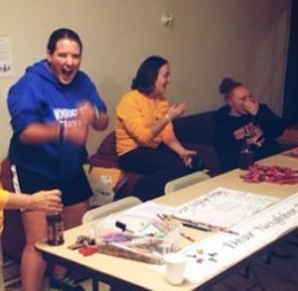
Three years ago, in an effort to enhance the academic experience and social growth of students, Chestnut Hill College began a program called Themed Living Communities (TLC).
In recent years, TLCs have become popular across college campuses as they afford students an opportunity to share housing with peers who, among other things, may share the same interests, values and academic goals. Currently, Chestnut Hill houses two such communities, First-Year Honors and First-Year LENS.
“You’re always kind of self-evaluating and thinking of what improvements to the program can be made next,” says Jenn Thorpe, director of residence life for 10 years. “When I felt the department was in a good and stable place, investigating the possibility of TLCs was just one of those things.”
Thorpe, who during her 21-year career had worked on college campuses with TLCs, began the experiment at Chestnut Hill back in 2007. At the time, there was only limited interest as just 17 students participated in the two programs, leadership and service and performing arts. By 2008, that number fell even further, to just 14 across three communities.
But Thorpe and her staff refused to give up, believing that “until there is zero interest” the living communities were still worth pursuing.
“We decided to take a break and find a program that existed to build a living community from in order to give us a stronger foundation,” says Thorpe.
In the fall of 2012, with the help of Kathy Duffy, SSJ, director of the Interdisciplinary Honors Program, the Office of Residence Life created its first successful TLC, the First-Year Honors community.
“I think part of the motivation to do this with the Honors Program was to see if it would build community and I really think it has,” says Sister Kathy.
The students who choose to live in Honors housing are placed together in Fournier Hall, in a private wing, and sometimes with other upperclassmen who are in the program. There are no common area bathrooms; each room or suite has its own. A private lounge area gives students a place to gather together and study, work on homework or just socialize.
“In the mere sense of the students being all together, it’s created a built-in support system which is really the biggest strength of that particular TLC,” says Thorpe.
Sister Kathy echoes this sentiment, saying that the students are “a cohesive unit, able to succeed better because of the support of the other group members.”
The year following the immediate success of the Honors TLC, Thorpe and her staff chose to add another first-year community, this time in conjunction with the Office of Serving Learning’s Leadership, Engagement and Service (LENS) initiative, which brings together students a week before the start of the academic year to engage in a community service program.
Thriving on its own, the LENS housing has been a great addition for students in the program, allowing those students to expand their service-related endeavors beyond that first week. Their TLC has been so successful and well received, that Thorpe and her staff have been investigating upper-class TLCs that would bring together those interested in working with service learning and campus ministry.
“It’s been three years and it’s been good for us so I think it’s time to add another layer,” Thorpe said when discussing the growth of the TLC initiative.
In order to help determine just what that growth might be, Thorpe recently surveyed 20 students who had experience living in the Honors TLC. Ninety percent said that they would recommend a themed living community to another student while another 89 percent supported the notion that a TLC creates close community among the students living there. Overall, most of the students had nothing but positive things to say about the experience. They cited the forming of close bonds, the ability to peer review each other’s work, and the support system provided by everyone sharing the same academic hardships as some of the reasons they enjoyed living in a TLC.
One of the other benefits of the TLCs are the resident assistants (RAs). Thorpe and her staff try to select RAs with common interests to the community. In the case of Honors, this means appointing an RA to the wing who is in the Honors Program. For LENS, it means someone like ,Kait Ryan ’15 who has a love and passion for service.
“Service was a way for me to really immerse myself in the world outside of CHC and meet the dear neighbor in a variety of different ways,” says Ryan. “So when Res Life asked me to live in the LENS hallway, I knew I needed to say yes.
“Being able to share my love of joy and service with my residents as well as hear their stories about their service and participate in service with them, was truly special,” Ryan adds. “I think for them, it was another layer to the community and created this great bond among all of us.”
Overall, the first-year communities have thrived, having Thorpe looking toward the future.
“I feel really great about the first-year communities,” she says. “Hopefully we can grow more opportunities from there.”
Visit the Office of Residence Life online.
—Marilee Gallagher ’14



